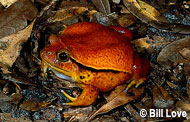Description:
This species is easily cared for under captive conditions. A 10 gallon aquarium can be used to house up to a pair of these rather sedentary frogs. A plastic sweater box can also be used, provided there is adequate ventilation. Suitable substrates include: peat or green moss, coco coir, or coco coir mixed in equal parts with orchid bark. Philodendron or pothos are suitable plants for use in a terrarium housing these animals. A water bowl with 1 to 2 inches of water at the bottom should also be included. Dechlorinated tap water or spring water should be used for adding moisture to the substrate or water bowl. The entire enclosure should be kept clean. If paper towels are used as a substrate, these should be changed at least every other week. Organic substrates can be changed more infrequently, but should be changed at least once a month. Temperatures between 75 and 85 degrees Fahrenheit during the day and down into the mid-60s at night are suitable for this species. A full spectrum light should be used for approximately 12 hours daily, especially if there are live plants in the cage. Tomato frogs are voracious feeders in captivity. Crickets provide a suitable staple, but these should be supplemented with mealworms, silk moth larvae, tomato hornworm larvae and the occasional pinky mouse. These frogs should be fed two to three times per week to maintain adequate body weight. Food items should be dusted with a vitamin/mineral supplement once weekly for adult frogs, and at every feeding for juveniles still undergoing periods of rapid growth. Uneaten or dead food items should be removed to prevent soiling of the enclosure.
Habitat:
This species is known to inhabit the swamps and shallow pools in the lowlands of Madagascar.
Range:
Disjunct range across eastern Madagascar.
Scientific Name: Dyscophus guineti
Species Group: frog
Family: Microhylidae
Size: 2 to 4 inches in total length; males are smaller than females.
Level: beginner
Weight: N/A
Dangerous: No



